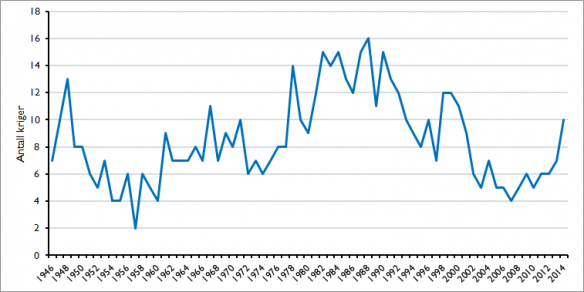On 22 December I reported in this blog on an article by political science professor Øyvind Østerud 18 December in the leading Norwegian newspaper Aftenposten that attacked Steven Pinker and ‘large parts of peace research’ for using ‘relative numbers’, i.e. numbers weighted by population, to assess long-term trends in the severity of war. In my brief response to Østerud, published in the print version of Aftenposten on 28 December, I pointed out that both absolute and relative numbers of battle-related deaths have declined after World War II. I also argued that although criticizing established truths is an important part of the research process, skepticism alone does not advance science. (I posted a longer version in the comment field to Østerud’s article as well as on this blog.) Østerud responded on 2 January and acknowledged that ‘absolute numbers belong to the same breath as relative numbers’. In a further rejoinder published on 3 January I queried Østerud on the nature of the column in which he published his original article. This column is dedicated to exposing ‘incompetent research, poor popularization, political proposals without a knowledge base, and sheer fraud’. Which of these four deadly sins were committed by Steven Pinker and assorted peace researchers? This question remains unanswered.
On 6 January the Uppsala Conflict Data Program issued a press release pointing to ‘an unusual increase in the incidence of war. There were seven ‘wars’ (armed conflicts with more than 1,000 battle deaths in a calendar year) in 2013 and preliminary figures indicate that there were ten in 2014. (The final figures will be published in the annual update that appears in the July issue of Journal of Peace Research.) The Norwegian site forskning.no asked Håvard Hegre, Øyvind Østerud, and me to comment on the press release. In my comment, I stressed that there are frequent ups and downs in the number of ongoing armed conflicts as well as the number of ongoing wars, and that the long-term trends are more important. Ida Rudolfsen of PRIO’s Conflict Trends project generated a following figure for the number of wars, 1946–2014, incorporating the preliminary 2014 figure from UCDP:

Number of wars (>1000 killed), 1946-2014
This graph indicates that the number of wars is still considerably lower than the peak at the end of the Cold War. The number of annual battle-related deaths also remains lower. The many conflicts in the Middle East and the increased tension between Russia and the West are obvious sources of concern, but do not yet amount to a reversal of the reduction in armed conflict after the end of the Cold War. The UCDP press release points to hopeful signs in 2014 in Columbia and in the Philippines (the Mindanao conflict). I would add to this the beginnings of a new relationship between Cuba and the US. Although there is no direct armed conflict between the two, this could have a positive influence in the Americas more generally.
The report from forskning.no was published in VG, 18 January and in very abbreviated form in Vesterålen 21 January. Østerud used the occasion to launch an attack on the UCDP: ‘research based on their data can be more misleading than informative’. UCDP uses an old-fashioned definition of war and does not catch the largest conflicts, such as the bloody conflicts around the narcotics cartels in Mexico. In the same interview, Håvard Hegre points out that it is incorrect that the conflicts that are not recorded by the UCDP are the bloodiest. Even Mexican crime violence claims fewer lives than the state-based conflicts in Iraq and Syria. To be able to say anything about trends, we need clear and consistent definitions of the types of violence we are comparing.
Finally, Steven Pinker has just published an article in Sociology where he responds to an earlier review symposium on his book The Better Angels of our Nature. The review symposium is rather one-sided. Sociology is supposedly the ‘flagship journal’ of the British Sociological Association. For me personally, it is a melancholy reminder of why I left sociology and defected to political science. I hasten to add that there are now many younger Norwegian sociologists committed to the scientific enterprise!